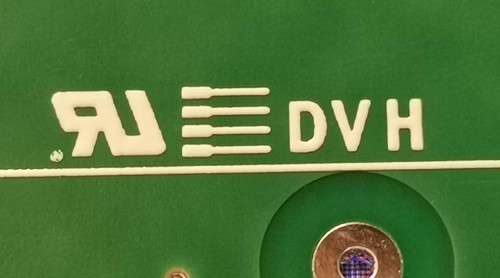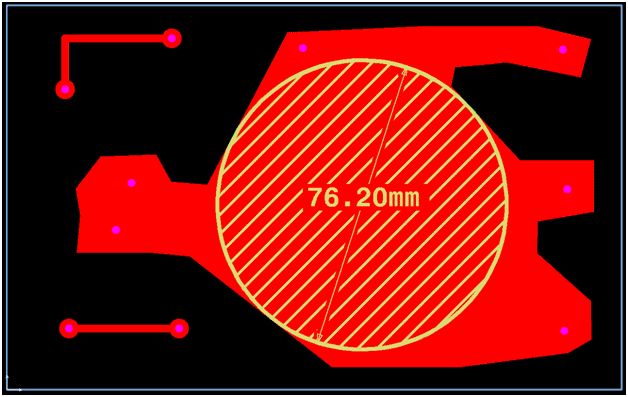What About Underwriters Laboratory (UL)?
What is the Underwriters Laboratory (UL)?
The Underwriters Laboratory (UL) was set up around 120 years ago in the USA as an independent facility to test the safety of new products and new technologies. Today it has a network of sites around the world focused on product safety. It test products, certifies manufacturers, and produces and updates safety standards across a broad range of industrial and commercial sectors.
Read more about UL here.
For printed circuit boards the main standards are UL 796, the specific PCB standard, and UL 94 for flammability testing of all plastics. These specify a number of performance tests to measure the long-term reliability and fire safety of the PCB. If a board is released to these standards, it is marked with the Underwriters Laboratory logo, the manufacturers logo and the board type.
The image below shows the UL logo – Eurocircuits Trade mark – Eurocircuits UL designator – Eurocircuits factory ID.
When is the Underwriters Laboratory Marking Used?
UL marking is required whenever safety, especially flammability, is a critical issue. For European OEM’s (original equipment manufacturers) it is often required on any boards that go into equipment that will be imported into the USA. The requirement may be set by the OEM or by the end customer.
What does Underwriters Laboratory Marking Mean?
- The base material meets the specified flammability level laid down in UL94. For FR4 the level required is UL94 V0. This means that when a vertical sample of the material is introduced into the test flame and then removed, it will self-extinguish within 10 seconds and will not drip flaming particles.
All Eurocircuits FR4 materials meet the requirements of UL 94 V0. For boards requiring UL marking we use Isola and Nan Ya materials
- For multilayer boards we use IS400 Mid Tg 150°C (this Tg is higher than standard FR4 to ensure full compatibility with lead-free soldering).
- For all high Tg (170° – 180° C) requirements we use Isola PCL-FR4-370-HR.
- For one and two layer boards we use IS400 Tg 150°C or Nan Ya NP-155F Tg 150°C
=> For more information on the properties visit the UL website and search for the following UL Certificates E41625 for Isola materials and E98983 for the Nan Ya material.
- The base material meets the specified level for ability to resist ignition from electrical sources. For the values see E41625 and E98983.
- The base material meets the specified electrical breakdown (tracking) or Comparative Tracking Index (CTI) value. This is the voltage difference at which the insulation properties of the base material may break down, causing safety and performance issues. The Isola and Nan Ya FR4 materials meet the requirements of Class 3 (175 – 249 V).
- The base material meets the performance profile levels specified for direct support of current carrying PCBs (DSR). These are specified in UL Standard ANSI/U/796A.
- The boards meet the other specifications set out in the table under UL marking in PCB proto, STANDARD pool and DEFINED IMPEDANCE pool below.
Eurocircuits Underwriters Laboratory Specifications
Our UL certificates E142920 can be found on our Download page.
Abbreviations used
- Cond = Conductor
- Edge = Please see the table and related sections below.
- Thk = Thickness
- SS = One copper-clad side
- DS = Two copper clad sides including single-sided and multilayer
- DSO = Double-sided only
- Max Area Diameter: this is explained below
- Meets UL796 DSR requirement. See item 4 above.
- CTI = Comparative Tracing Index. See item 3 above.
TIPS
-
- UL marking is free of charge.
- To add UL marking to your order, click on “Advanced options” section in the PCB Configurator and then select the “Yes” next to the “UL marking” option.
- When data has been uploaded, the Marking editor can be used to define the UL logo position.
General.
- We offer UL marking in PCB proto, STANDARD pool or DEFINED IMPEDANCE pool only.
- All boards requiring UL marking are either made in our factories in Eger, Hungary or Aachen, Germany.
- Active board classes, each with its own UL marking:
The other classes listed in the certificate are no longer used
UL Marking in PCB proto, STANDARD pool and DEFINED IMPEDANCE pool
UL marking is only available for PCB’s which conform to the parameters listed here (the numbers in brackets indicate further information below). This includes poolable and non-poolable options.
UL type Designator |
ML H / AM G |
DV H / AS G |
|
Usable for |
Multilayer |
Single and Double Sided |
| Base Materials |
IS400 PCL-FR-370HR |
IS400 NP-155F PCL-FR-370HR |
|
UL 94 Flame Class |
V-0 |
V-0 |
|
Min. Build-up Thickness (mm) (1) |
0,63 |
0,63 |
|
Min. Bonding Sheet (prepreg) Thickness (microns) (2) |
126 |
– |
|
Minimum Outer Layer Conductor Thickness (microns) (3) |
18 |
18 |
|
Maximum Inner Layer Conductor Thickness (micron) (4) |
70 |
– |
|
Minimum Track Width (mm) (5) |
0,10 |
0,10 |
|
Minimum Edge Track Width (mm) (6) |
0,15 |
0,15 |
|
Maximum Conductor Area Diameter (mm) (7) |
76,20 |
76,20 |
|
Surface Finishes: Lead-free HAL Immersion NiAu (ENIG) Immersion Ag |
Yes Yes Yes |
Yes Yes Yes |
|
Hard Gold Edge Connector |
Yes |
Yes |
|
PTH on the Board Edge |
Yes |
Yes |
|
Round-edge Plating |
Yes |
Yes |
|
Copper up to Board Edge |
Yes |
Yes |
|
Carbon Paste |
Yes |
Yes |
|
Via Fill with Resin |
No |
No |
|
Heatsink Paste (8) |
NO |
NO |
|
Soldermask Types (9) |
ELPEMER SD_2407 XV501T Screen XV501T-4 Screen Electra EMP110 |
ELPEMER SD_2407 XV501T Screen XV501T-4 Screen Electra EMP110 |
|
Peelable Soldermask |
Yes |
Yes |
|
Carbon Ink |
SD 2843 HAL |
SD 2843 HAL |
|
Solder Limit Maximum Temperature (°C) (10) |
265 |
265 |
|
Solder Limit Maximum Time (sec) (10) |
20 |
20 |
|
Maximum Operating Temp (°C) |
130 |
130 |
2. Minimum Bonding Sheet (prepreg) Thickness (microns)
Minimum prepreg thickness in a multilayer. This may be one prepreg or a combination of different prepreg.
ML H / AM G |
DV H / AS G |
|
|
UL min. Bonding Sheet (prepreg) Thickness (microns) |
63 |
– |
The PCB Configurator will flag any pre-defined build that are not UL-compatible.
3. Minimum Outer Layer Conductor Thickness (microns)
Specifies the minimum END copper thickness for the outer layers.
ML H / AM G |
DV H / AS G |
|
|
UL min. Outer Layer Conductor Thickness (microns) |
18 |
18 |
For 2-layer and multilayer boards all start copper foil thicknesses may be used: 12µm (end +/-30µm), 18µm (end +/-35µm), 35µm (end +/-60µm), 70µm (end +/-95µm) and 105µm (end +/-130µm).
For 1-layer boards the start copper foil is the same as the end copper thickness, so following start copper foils are available: 35µm (end +/-35µm), 70µm (end +/-70µm) and 105µm (end +/-105µm).
4. Maximum Inner Layer Conductor Thickness (micron)
Specifies the maximum END copper thickness for the inner layers.
ML H / AM G |
DV H / AS G |
|
|
UL max. Inner Layer Conductor Thickness (micron) |
70 |
– |
On inner layers start copper foil is the same as end copper thickness. UL marking is available only for 12µm, 18µm, 35µm and 70µm (not 105 µm)
6. Minimum Edge Track Width (mm)
The minimum width of any track on any layer placed less than 0.40mm from the edge of the PCB-board.
ML H / AM G |
DV H / AS G |
|
|
UL min. Edge Track Width (mm) |
0,15 |
0,15 |
This is a UL requirement to prevent damage to fine tracks near the edge of the PCB.
NOTE
To Eliminate the Min Edge Track width restriction of 0.15mm (limit Pattern Class 6), we impose the Front-End rule that in case of a UL-requirement on a PCB, there can be no copper tracks or pads within 0.40mm of the board edges.
7. Maximum Conductor Area Diameter (mm)
This specifies the maximum solid, unpierced conductor area on any layer of a PCB-board, measured by the diameter of the largest circle that can be inscribed within the conductor pattern.
ML H / AM G |
DV H / AS G |
|
|
UL max. Conductor Area Diameter (mm) |
76,20 |
76,20 |
A “solid, unpierced copper area” is defined as any “full” or “solid” copper plane that does not have any PTH or NPTH holes in it. This rule has been introduced by UL to reduce the thermal mismatch between a large solid copper plane and the laminate.
The diameter is measured thus:
TIPS
-
- In most cases copper planes will include clearances for drill holes and so are not solid. Otherwise if UL marking is required for designs with very large unbroken copper areas, consider adding a drilled hole or an opening in the copper area.
If you have any questions, please contact us by email at euro@eurocircuits.com
or use our online Chat.


